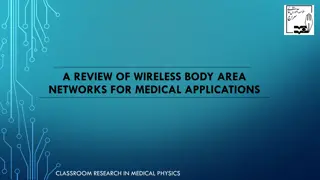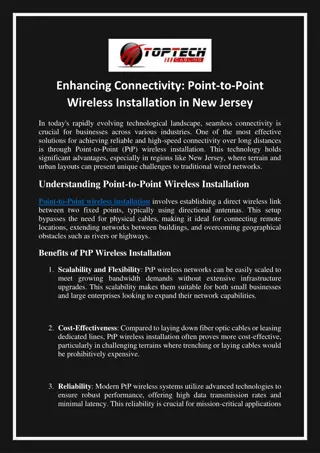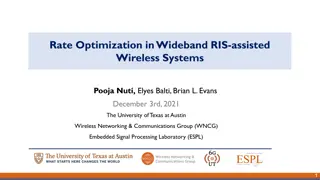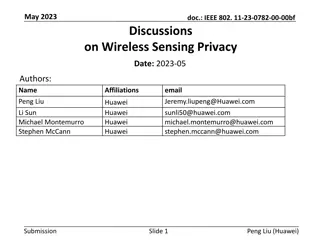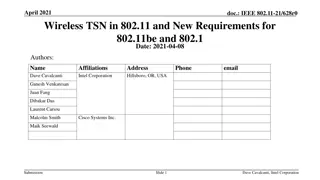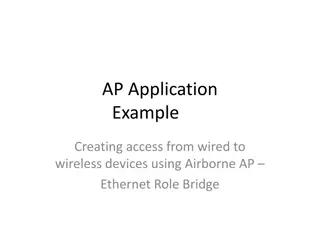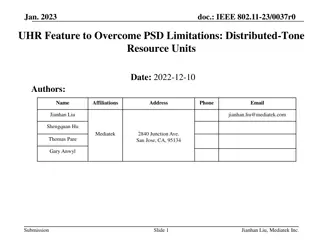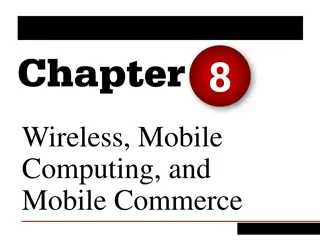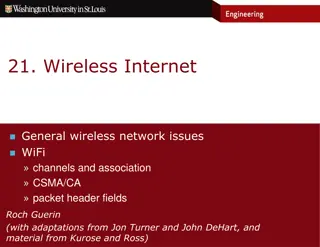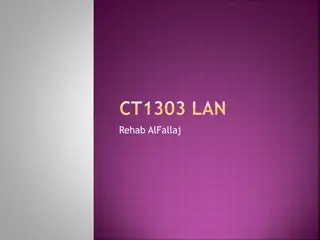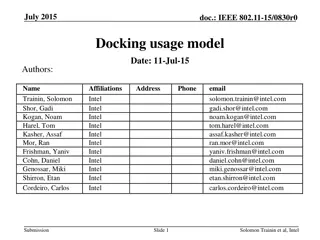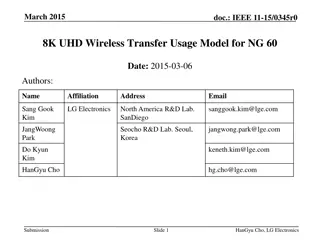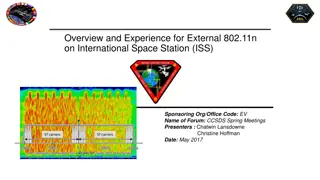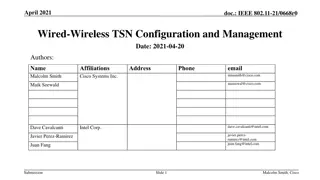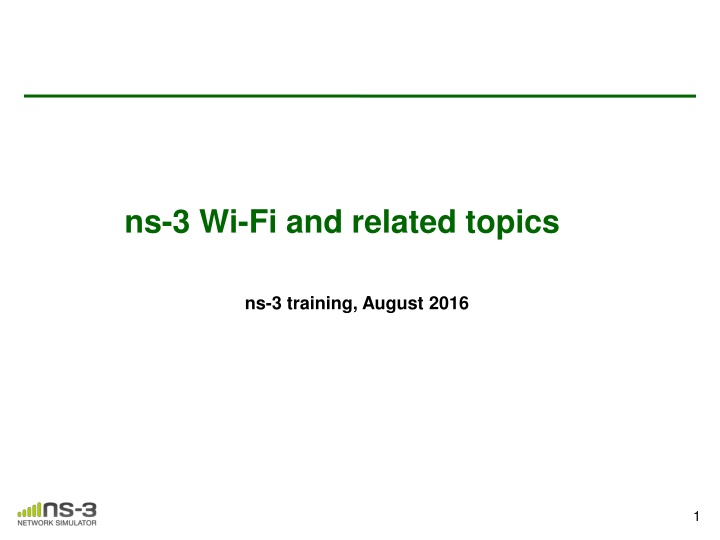
Exploring ns-3 Training on Wi-Fi and Related Topics
Delve into a comprehensive ns-3 training session focused on Wi-Fi and related topics, covering in-depth insights on Wi-Fi architecture, configuration, advanced use cases, rate controls, MAC high and low models, and more. Explore Wi-Fi fundamentals, DCF implementation, QoS support, infrastructure modes, rate adaptation algorithms, and advanced features like MIMO and mesh networks. Gain a solid understanding of MAC layer components, rate control algorithms, and packet processing in Wi-Fi networks.
Download Presentation

Please find below an Image/Link to download the presentation.
The content on the website is provided AS IS for your information and personal use only. It may not be sold, licensed, or shared on other websites without obtaining consent from the author. If you encounter any issues during the download, it is possible that the publisher has removed the file from their server.
You are allowed to download the files provided on this website for personal or commercial use, subject to the condition that they are used lawfully. All files are the property of their respective owners.
The content on the website is provided AS IS for your information and personal use only. It may not be sold, licensed, or shared on other websites without obtaining consent from the author.
E N D
Presentation Transcript
ns-3 Wi-Fi and related topics ns-3 training, August 2016 1
Outline Wi-Fi in detail Support of standard features Architecture Configuration via helpers Advanced use case: LAA-Wifi-Coexistence SpectrumWifiPhy Adding a LBT Access Manager Scenario support Output data processing 2 ns-3 training, August 2016
Wi-Fi Overview WiFi module features DCF implementation (Basic + RTS/CTS) 802.11 a/b/g/n/ac (2.4 & 5 GHz) PHY MSDU/MPDU aggregation QoS support (EDCA) Infrastructure and ad-hoc modes Many rate adaptation algorithms AWGN-based error models Unsupported features MIMO 11ac advanced features (Tx beamforming, Mu-MIMO) Related modules Mesh (802.11s) and WAVE (802.11p/vehicular) 3 ns-3 training, August 2016
Wi-Fi Architecture 4 ns-3 training, August 2016
MAC High Presently, three MAC high models AdhocWifiMac: simplest one ApWifiMac: beacon, associations by STAs StaWifiMac: association based on beacons All inherit from RegularWifiMac, which handles QoS and non-QoS support 5 ns-3 training, August 2016
Rate controls The following rate control algorithms can be used by the MAC low layer: Algorithms found in real devices: ArfWifiManager (default for WifiHelper), OnoeWifiManager, ConstantRateWifiManager, MinstrelWifiManager, MinstrelHtWifiManager Algorithms in literature: IdealWifiManager, AarfWifiManager, AmrrWifiManager, CaraWifiManager, RraaWifiManager, AarfcdWifiManager, ParfWifiManager, AparfWifiManager Example use of constant rate std::string phyMode ("OfdmRate54Mbps"); wifi.SetRemoteStationManager ("ns3::ConstantRateWifiManager", "DataMode",StringValue (phyMode), "ControlMode",StringValue (phyMode)); 6 ns-3 training, August 2016
MAC Middle/Low Three components: MacLow RTS/CTS/DATA/ACK transactions Aggregation, Block acks DcfManager implements the DCF DcaTxop and EdcaTxopN: One for NQoS, the other for QoS Packet queue Fragmentation/Retransmissions 7 ns-3 training, August 2016
Current Wi-Fi PHY abstraction 8 ns-3 training, August 2016
Physical layer No AGC model Sync on first RX with energy > detection threshold Collision: the error model will likely cause a drop of the packet No capture effect: won t re-sync on a stronger packet 9 ns-3 training, August 2016
Error models Based on analytical models with error bounds Three implementations with different bounds: YansErrorRateModel, NistErrorRateModel, DssErrorRateModel NistErrorRateModel (OFDM) DsssErrorRateModel 10 ns-3 training, August 2016
Interference helper SINR evaluated on chunk-by-chunk basis 11 ns-3 training, August 2016
Configuring 802.11n/ac Example programs include examples/wireless/ht-wifi-network.cc examples/wireless/vht-wifi-network.cc examples/wireless/wifi-aggregation.cc Setting the WifiPhyStandard will set most defaults reasonably WifiHelper wifi; wifi.SetStandard (WIFI_PHY_STANDARD_80211ac); WifiMacHelper mac; 802.11ac uses 80 MHz channel by default; 802.11n uses 20 MHz 12 ns-3 training, August 2016
802.11n/ac rate controls Possible options are IdealWifiManager, MinstrelHtWifiManager, and ConstantRateWifiManager examples: src/wifi/examples/ideal-wifi-manager- example.cc src/wifi/examples/minstrel-ht-wifi-manager- example.cc 13 ns-3 training, August 2016
Example output for MinstrelHt $ ./waf --run "minstrel-ht-wifi-manager-example --standard=802.11n-5GHz" $ gnuplot minstrel-ht-802.11n-5GHz-20MHz-LGI-1SS.plt 14 ns-3 training, August 2016
Typical configuration std::string phyMode ("DsssRate1Mbps"); NodeContainer ap; ap.Create (1); NodeContainer sta; sta.Create (2); WifiHelper wifi; wifi.SetStandard (WIFI_PHY_STANDARD_80211b); YansWifiPhyHelper wifiPhy = YansWifiPhyHelper::Default (); // ns-3 supports RadioTap and Prism tracing extensions for 802.11 wifiPhy.SetPcapDataLinkType (YansWifiPhyHelper::DLT_IEEE802_11_RADIO); YansWifiChannelHelper wifiChannel; // reference loss must be changed since 802.11b is operating at 2.4GHz wifiChannel.SetPropagationDelay ("ns3::ConstantSpeedPropagationDelayModel"); wifiChannel.AddPropagationLoss ("ns3::LogDistancePropagationLossModel", "Exponent", DoubleValue (3.0), "ReferenceLoss", DoubleValue (40.0459)); wifiPhy.SetChannel (wifiChannel.Create ()); 15 ns-3 training, August 2016
Typical configuration (cont.) // Add a non-QoS upper mac, and disable rate control WifiMacHelper wifiMac; wifi.SetRemoteStationManager ("ns3::ConstantRateWifiManager", "DataMode",StringValue (phyMode), "ControlMode",StringValue (phyMode)); // Setup the rest of the upper mac Ssid ssid = Ssid ("wifi-default"); // setup ap. wifiMac.SetType ("ns3::ApWifiMac", "Ssid", SsidValue (ssid)); NetDeviceContainer apDevice = wifi.Install (wifiPhy, wifiMac, ap); NetDeviceContainer devices = apDevice; // setup sta. wifiMac.SetType ("ns3::StaWifiMac", "Ssid", SsidValue (ssid), "ActiveProbing", BooleanValue (false)); NetDeviceContainer staDevice = wifi.Install (wifiPhy, wifiMac, sta); devices.Add (staDevice); 16 ns-3 training, August 2016
Typical configuration (cont.) // Configure mobility MobilityHelper mobility; Ptr<ListPositionAllocator> positionAlloc = CreateObject<ListPositionAllocator> (); positionAlloc->Add (Vector (0.0, 0.0, 0.0)); positionAlloc->Add (Vector (5.0, 0.0, 0.0)); positionAlloc->Add (Vector (0.0, 5.0, 0.0)); mobility.SetPositionAllocator (positionAlloc); mobility.SetMobilityModel ("ns3::ConstantPositionMobilityModel"); mobility.Install (ap); mobility.Install (sta); // other set up (e.g. InternetStack, Application) 17 ns-3 training, August 2016
Athstats helper Hooks Wi-Fi traces to provide debugging similar to Madwifi drivers Example athstats output from example ./waf --run wifi-ap m_txCount m_rxCount unused short long exceeded rxError 0 0 0 0 0 0 0 0 0 0 0M 0 60 0 0 0 0 0 0 0 0 0M 0 123 0 0 0 0 0 0 0 0 0M 0 122 0 0 0 0 0 0 0 0 0M 0 122 0 0 0 0 0 0 0 0 0M 0 122 0 0 0 0 0 0 0 0 0M 0 122 0 0 0 0 2 0 0 0 0M 0 122 0 0 0 0 23 0 0 0 0M 0 122 0 0 0 0 14 0 0 0 0M 0 122 0 0 0 0 14 0 0 0 0M 0 122 0 0 0 0 26 0 0 0 0M 0 122 0 0 0 0 12 0 0 0 0M 18 ns-3 training, August 2016
Future directions see Wi-Fi roadmap presentation 19 ns-3 training, August 2016
LTE/Wi-Fi Coexistence 20 ns-3 training, August 2016
Use case: LAA Wi-Fi Coexistence ns-3 has been extended to support scenarios for LTE LAA/Wi-Fi Coexistence Methodology defined in 3GPP Technical Report TR36.889 Enhancements needed: Wireless models (LBT access manager, SpectrumWifiPhy, propagation/fading models) Scenario support (traffic models) Output data processing 21 ns-3 training, August 2016
Indoor 3GPP scenario 120 m 5 UEs/STAs per cell per operator (40 total) randomly dropped Downlink on shared channel; LAA has separate licensed uplink 4 co-channel cells per operator (eNB or Wi-Fi AP) 50 m Step 1: Both operators A and B are Wi-Fi co-channel on separate SSID Step 2: (depicted) Replace operator A network with LTE LAA Non-mobile indoor scenario Idealized backhaul to traffic sources 22 ns-3 training, August 2016
Indoor scenario details 23 ns-3 training, August 2016
Outdoor 3GPP scenario Outdoor layout: hexagonal macrocell layout. 7 macro sites and 3 cells per site. 1 Cluster per cell. 4 small cells per operator per cluster, uniformly dropped. ITU UMi channel model. Distance between cluster and macro node Dmacro-cluster R1 Macro Node R2 Cluster 1 R1: radius of small cell dropping within a cluster; R2: radius of UE dropping within a cluster Figure source: 3GPP TR 36.889 V13.0.0 (2015-05) 24 ns-3 training, August 2016
References ns-3 Wiki page: https://www.nsnam.org/wiki/LAA-WiFi- Coexistence module documentation references to various publications documentation on reproducing results Code: http://code.nsnam.org/laa/ns-3-lbt 25 ns-3 training, August 2016
Sample results These flows (the majority in the scenario) experience no contention and achieve close to the MCS 15 limit Small amount of throughput degradation for the non-replaced Wi-Fi network Some flows experience contention and slow down a) Step 1 (Wi-Fi) b) Step 2 (LAA) 26 ns-3 training, August 2016
Wi-Fi enhancements 27 ns-3 training, August 2016
Model enhancements: Wi-Fi Spectrum Wi-Fi Phy implementation Wi-Fi preamble detection based on AWGN and TGn Channel Model D Wi-Fi RSS-based AP selection and roaming Wi-Fi MIMO approximations to support 2x2 DL, 1x2 DL on AWGN and TGn Model D 28 ns-3 training, August 2016
Model enhancements: LTE LTE interference model relies on the simplifying assumption that all interfering signals are LTE and are synchronized at the subframe level. LTE inteference model has been enhanced to handle inteference by signals of any type. This relies on the ns-3 Spectrum framework. The reception of LTE signals is evaluated by chunks, where each chunk is identified by a constant power spectral density. 29 ns-3 training, August 2016
Scenario An initial test scenario, useful for testing basic model operation in a small scale setting, grew into TR36.889-like indoor and outdoor scenarios D1 and d2 can vary and operator A and B can be both LTE or Wi-Fi 30 ns-3 training, August 2016
Output experiment scripts Shell scripts and gnuplot helpers to manage configuration and data output (demonstrate) 31 ns-3 training, August 2016
Status Portions are being migrated into ns-3-dev SpectrumWifiPhy in ns-3.26 LTE components, propagation model likely in ns-3.27 Scenario helper may be rewritten Trying to decompose into pieces easy to merge For more information: https://www.nsnam.org/wiki/LAA-WiFi-Coexistence 32 ns-3 training, August 2016

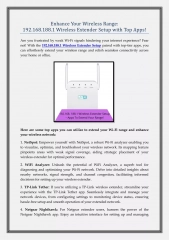

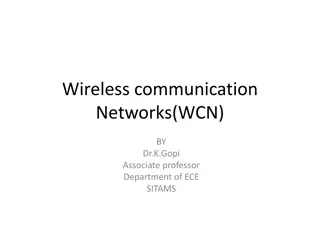

![Long-Range Wireless Charging Market Report & Analysis _ BIS Research [2024-2035]](/thumb/87166/long-range-wireless-charging-market-report-analysis-bis-research-2024-2035.jpg)
